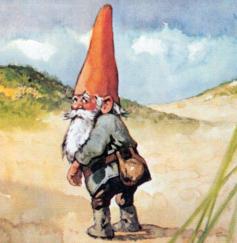
Gnomes are very widespread species, known to a number of human races. Germans name them Erdmanleins, except in the Alpine areas, where they are called Heinzemannchens. In Denmark and Norway they are Nisse; Nissen is a Swedish variation. In Brittany they are called Nains. Tontti to the Finns and Foddenskkmaend is their name in Iceland. The Polish call they by the familar Gnom. Bulgaria and Albania, however, use Dudje. In Hungary, Yugoslavia, and Czechoslovakia, Gnomes are called Mano. The Dutch use Kabouter and the Belgian, Skritek. Switzerland and Luxembourg use the same name, Kleinmanneken, which means "littlemen." Domovoi Djedoes is used in western Russia.
Race :Gnomes consist of a number of different types. The most common is the Forest Gnome who rarely comes into contact with man. The Garden Gnome lives in old gardens and enjoys telling melancoly tales. Dune Gnomes are slightly larger than their woodland breathren and choose remarkably drab clothing. House Gnomes have the most knowledge of man, often speaking his language. It is from this family that Gnome Kings are chosen. Farm Gnomes resemble their House brethen, but are more conservative in manner and dress. Siberian Gnomes have been more interbred than other Gnomes and associate freely with trolls. They are much larger than the other types and have an infinately more nasty nature. It is best never to evoke the ire of such Gnomes for they delight in revenge.
Origin : Believed to be originating in Scandinavia, Gnomes later migrated to the lowlands some 1500 years ago.
Description : Gnomes are usually an average of 15 centimeters tall (but in some stories they are said to be around a foot (30 cm) in height), but with its cap on it appears much taller. Their feet are somewhat pigeon toed which gives them an extra edge on speed and agility through the wood and grass. The males weigh 300 grams, and female is 250-275 grams. The male wears a peaked red cap, a blue brown-green pants, and ether felt boots, birch shoes, or wooden clogs. Around his waist is a belt with a tool kit attached, holding a knife, hammer, etc. They are fair of face, though the boast rosy red cheeks. Long beards adorn their faces and turn gray far sooner than their hair. The female wears gray or khaki clothing, consisting of a blouse and skirt (to ankles). She also has black-gray knee socks and high shoes or slippers. Before she is married, she dons a green cap. Prior to marriage her hair in hanging down, the outfit is complemented by a green cap and braids with which later disappear under a scarf while the green cap is replaced by more somber tones after she marries.
Friends/Foes :Males are the guardians of animal kind and show little preference for their animal friends, not withstanding their aversion to cats both wild and domesticated. They are known for freeing wildlife from man's traps and for operating on farm animals whose owners have neglected them or who are simply to poor to afford a vetrinarian. Their enemies are mainly Trolls, and other beings who would try to destroy them or their homes. Otherwise, they are mostly peaceful beings.
Lore : Gnomes tend to live in hilly meadows and rocky woodlands. In Huygen's book, it says they live in three trees, the house itself, with a hidden entrance from another tree, and then a third is the supply room, with grains, beans, potatoes and everything else the gnomes may need during the winter.
Powers :Most Gnomes are 7 times stronger than a man, can run at speeds of 35 miles per hour, and have better sight than a hawk. These abilities help the Gnome to do many things, such as find wounded, dying animals for which they feel they are responsible for. Because of their love for animals, all the animals of the forest are the Gnome's friends and are willing to help him at any time. Many people say that gnomes have elevated practical jokes to an art form. But most especially they love gems and jewelry and are considered by many to be the best gem cutters and jewelers in existence
Element : Earth They are generally vegetarian and never worry. The main meal consists of: Nuts (hazelnuts, walnuts, beechnuts, etc), mushrooms, peas, beans, a small potato, applesauce, fruit, berries (all kinds), tubers, spices, vegetables, and preserves for dessert. As a beverage, the gnome drinks mead dew (fermented honey), fermented raspberries (which have a very high alcohol content), and spiced gin as a nightcap. The gnome eats no meat, so often consumes the nectar of the high rotein plant called
'Vicia Sepuim'. fluffy willow catkins, dressing them up like dolls.





 The gnomes before gnomes.
- XenonZe
The gnomes before gnomes.
- XenonZe